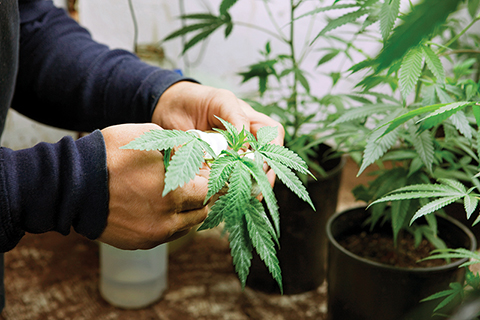Marijuana is a great painkiller but its medical use has long been limited by its celebrated side effects, especially short-term memory loss and feelings of giddiness. Now a new study by scientists at U of T and other institutions suggests there may be ways to separate out the plant’s effects and target its beneficial powers more tightly.
THC, the key ingredient in marijuana’s signature “high,” acts on a particular receptor in the brain. But new research has found that when people are exposed to cannabis, this receptor orders the production of a chemical that acts to limit or “dial down” the impact of the THC. In other words, the brain has its own built-in safety valve that acts to lessen the high. If a way could be found to intensify the effects of this safety valve, marijuana’s high-inducing properties could be neutralized while leaving its analgesic powers intact.
Scientists don’t yet know whether this chemical – called pregnenolone – acts as a simple on-off switch or as something more complicated like a dimmer. Nor is it precisely clear how it works in people (the research was conducted on mice). But the discovery could lead to better medical applications of cannabis, says Ruth Ross, chair of U of T’s pharmacology department and one of the authors of the study.
Scientists have long known about pregnenolone, but not realized its importance, notes Ross, who has been researching cannabis for 20 years. “Understanding what it does introduces a whole new area of drug discovery,” she says. Additional research into the chemical’s properties could lead to the development of new medicines for appetite suppression or stimulation, pain relief and even addiction management, since the same brain receptors that produce pregnenolone in response to THC are also involved in nicotine addiction. “It could be that understanding pregnenolone will help us to treat addictions generally,” Ross says.
Some 41,000 Canadians are already registered users of medical marijuana and that number is expected to rise to more than 300,000 in the next decade. But at the moment, says Ross, “cannabis is a double-edged sword.” It’s very effective at managing the pain associated with conditions such as multiple sclerosis and certain kinds of cancer. But it’s limited because of its effects on mood and memory. “The pleasant effect of making you high is not so pleasant if you have a long-term medical condition and you’re trying to lead a normal life. People who are taking a medicine want something that can relieve their pain but allow them to function normally.”
Understanding the role of pregnenolone might lead to the development of new strains of the marijuana plant, but Ross is more interested in developing more targeted forms of medication. Cannabis contains 60 to 100 compounds and while some or all of them may be necessary for the plant’s medicinal effect, it’s also possible that a single compound would work better – or at least with fewer side effects.
“The system of receptors in our brain that responds to marijuana wasn’t developed for us solely to smoke cannabis,” says Ross. It’s involved in memory, mood, appetite and pain signalling, and it’s important not to disrupt this system with the mixture of chemicals in the plant. Pregnenolone may provide the inspiration for subtler interventions.
Recent Posts
U of T’s 197th Birthday Quiz
Test your knowledge of all things U of T in honour of the university’s 197th anniversary on March 15!
Are Cold Plunges Good for You?
Research suggests they are, in three ways
Work Has Changed. So Have the Qualities of Good Leadership
Rapid shifts in everything from technology to employee expectations are pressuring leaders to constantly adapt







One Response to “ Herb Appeal ”
Thank you, thank you, thank you! The last sentence of the second paragraph is exactly what I am seeking: pain relief with no high. I was trying different strains through the Toronto Compassion Centre but have yet to find one that helps with my pain. Now, new legislation has shut the Compassion Centre. I do not want to try the unknown strains being offered by the commercial growers. The dilemma is that we will be offered either indica or sativa or combinations but not the specific strains that we have found effective. The Compassion Centre offered me education and the chance to try different kinds of cannabis. I have, at this point, given up and will continue with the extremely harmful and potent pharmaceuticals that offer a measure of relief.